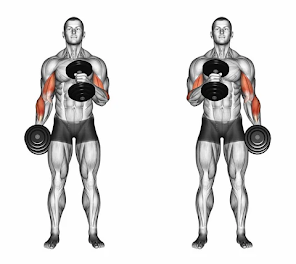Hammer Curl
The hammer curl is a great exercise for developing the biceps, brachialis and forearms. Unlike regular bicep curls, the hammer curl changes your grip so your palms face each other instead of up which sets it apart as an important exercise for arm workouts.
We will discuss the advantages of hammer curls, how to do them correctly, typical errors people make and ways to make them more effective.
Reasons to do Hammer Curls
1. Works on a Variety of Arm Muscles
Most of the hammer curl exercise’s benefits come from working:
.Biceps brachii (for an overall increase in arm size)
.Brachialis (a muscle below the biceps that makes the arm look thicker)
.Forearms include the brachioradialis and muscles that hold the wrist in place
.This means it works your arms more fully than a basic curl.
2. Helps Your Upper Body Get Bigger
Because the brachialis is used a lot in hammer curls, these exercises help make your arms look bigger and stronger, not just your biceps.
3. Improves how strong your grip and forearms are.
Using a neutral grip trains your forearm muscles more than regular curls which benefits your grip, necessary for deadlifts, pull-ups and other compound exercises.
4. Helps to Prevent Wrist Pain
A lot of lifters feel wrist pain when doing supinated curls. Since hammer curls use a neutral grip, your wrists are under less strain and are safer.
5. Helps Make Muscles Stronger
The movements are similar to what we do in real life such as carrying food or lifting things which helps build your daily strength and endurance.
How to Do Hammer Curls in the Right Way
Necessary Equipment: Dumbbells or resistance bands
Step-by-Step Guide:
1.Maintain Tall – Keep your feet around shoulder-width, slightly bend your knees and keep your core tight.
2.Hold the Dumbbells – Take a dumbbell in each hand, making sure your palms are facing in toward the center.
3.Start the Curl – Keep your elbows at your body’s sides, lift the weights up and hold the neutral grip.
4.Hold the Dumbbells at Shoulders – Stop for a moment when your arms are at shoulder height.
5.Go Down Slowly – Regulate the pace to get the best results from your muscles.
6.Repeat – Do 3-4 sessions of 8-12 repetitions.
Common Errors to Stay Away From:
.Swinging the weight – Using momentum means your muscles are not used as much. Make your movements measured.
.Spreading Elbows – This makes the triceps do most of the work. Bring your elbows in close to your body.
.Partial Range of Motion – Curling all the way up works out your muscles the most.
There are many versions of hammer curls.
1. Seated Hammer Curl
.Stay on the bench to minimize body sway in order to focus more on the muscles.
2. Cross-Body Hammer Curls
.Bring the dumbbell from your outer shoulder to your opposite shoulder to activate the brachialis muscle more.
3. Rope Hammer Curls (Using a Cable Machine)
.A cable machine equipped with a rope attachment gives a continuous force during the exercise.
4. Incline Dumbbell Curls
.Stretching your biceps more is possible by doing incline bench presses.
5. Zottman Curls
.Combines hammer curls with reverse curls to train the biceps, brachialis and forearms during one movement.
The Best Ways to Work Hammer Curls into Your Strength Training
.On arm day, do hammer curls along with exercises for your triceps such as dips or overhead extensions.
.Do rows and pull-ups together on Pull Day to exercise your upper body evenly.
.Do accessory lifts like hammer curls after you finish compound exercises such as deadlifts.
In order to improve, adjust the weight you lift as you maintain good technique.
Conclusion
Using the hammer curl helps improve arm strength, arm thickness and the ability to grip for a long time. No matter your level in weight training, regularly including hammer curls can improve the strength and appearance of your arms.
Keep doing different exercises, keep them under control and your arms will become stronger and more toned.




Post a Comment